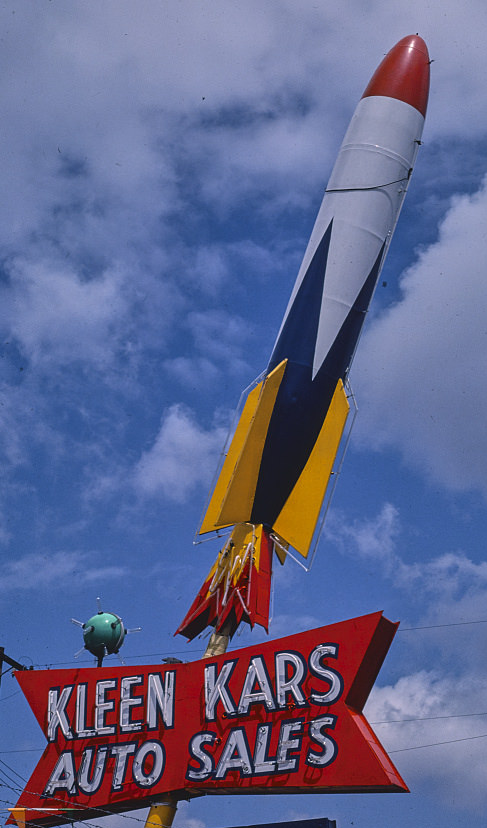The Coming Subprime Car Loan Collapse
The Coming Subprime Car Loan Collapse
Paper Plates
I watch one informal, unscientific indicator of the health of the economy in Southern California where I live: The number of vehicles with paper plates.
In California, all new cars get temporary paper plates until the permanent steel plates arrive in the mail. Those plates then stay with vehicle throughout its life in California.

Subprime car loan. A economic rocket ready to crash. The Library of Congress from Washington, DC, United States – Kleen Kars sign, Salt Lake City, Utah.1981
Used cars that came from out of state and used cars where the previous owner had vanity plates, also get paper plates when sold. Vanity plate owners are allowed to transfer their plates to the new cars they buy.
During the 42 years I have lived here, there have been three great ages of vehicle paper plates. The first was in the mid to late 80s when people were moving to southern California in droves. Another was in the 1990s. Both of these lasted about 18 months.
But the third paper plate age is unlike the others. It has been going full on since waning days of COVID epidemic (which actually never ended, just swept under the rug.) That’s nearly four years now.
Now I think I know why there’s an apparent extended car-buying.The two mains reasons appear to be leases and the rise of the subprime car loan. A third peripheral reason is Tesla slashing prices as sales of its overprice cars slowed. Leases and Tesla’s woes are another story.
If you hear a car dealer ad saying something like “we finance your future, not your past” they’re talking a subprime car loan.
But it’s subprime car loans that present the greatest danger to the economy as whole.
Alarm bells are ringing on Wall Street. The recent collapses of Tricolor, a used car seller and sub-prime auto lender, and First Brands, an auto parts supplier, have put the finance industry on edge, almost two decades after problems in the subprime mortgage lending market set the stage for the global financial crisis.
https://www.theguardian.com/business/2025/oct/17/us-car-repossessions-economy
New car registrations, a statistical proxy for the number of cars purchased in California, cratered in 2020 as the pandemic began. Monthly new car registration fell from about 150,000 in February 2020 to 44,000 in April 2020, according to data from the California Legislative Analyst’s Office.
https://lao.ca.gov/LAOEconTax/article/Detail/828
Problems in the auto loan industry have been manifesting for several years, as car prices rose sharply during the Covid-19 pandemic while inflation soared and interest rate increases followed. Paying off a new car required 42 weeks of income in 2023, according to Cox Automotive, up from about 33 before the pandemic.
High prices meant bigger loans. The average monthly repayment now stands at more than $750.
https://www.theguardian.com/business/2025/oct/17/us-car-repossessions-economy
It’s not hard to track this boom. Every time I drive I see new cars with papers plates or used cars with paper plates.
In years of non-booming car sales I might see maybe three or four paper cars with paper plates per week. Now I see many every day, often on very expensive cars, especially on Teslas and now Lucid electric vehicles. In the case of Tesla, it’s impossible to drive anywhere and not see several and I mean a lot.
Walk out my front door and I see two in my neighbors’ driveways.
But this isn’t just about electric cars or Teslas and Lucids. High end gas powered BMWs, Mercedes and Audis, and all manner of SUVs, are also part of this trend. None of these vehicles are exactly for budget minded driver. I was on a car lot a few months ago saw the sticker price of a Chevrolet Suburban, the original behemoth SUV, was more than $80,000.
There was a time here when people were holding on to their cars for longer. At the beginning of this sales boom I guessed that it may be due in part to pent up demand. But pent up demand fails to explain the duration of this new car buying boom.
How are people able to afford these cars? This was the mystery of the paper plates that now being exposed, a financial expose that threatens hurt the entire nation.
An estimated 100 million Americans hold auto loans, with 85% of new car purchases and 55% of used car purchases financed. It is the third-largest consumer credit market in the US, behind mortgages and student loans.
https://www.theguardian.com/business/2025/oct/17/us-car-repossessions-economy
Many people with cars loans are simply not able to afford their vehicles. Loan delinquencies repossessions have been increasing for several months.
And like the subprime mortgage industry back in 2008 fraud seems to be playing a role.
The Guardian:
Unlike First Brands, Tricolor sought bankruptcy protection last month under the shadow of fraud allegations that have prompted two federal investigations. Charles Gibbs, the attorney representing Tricolor’s court-appointed trustee, told a Texas court this month that initial reports “indicate potentially systemic levels of fraud”.“Tricolor’s failure is not necessarily indicative of what is immediately ahead for the sector as a whole, because of the special circumstances, but I would still see it as an economic warning indicator,” said Brett House, an economics professor at Columbia Business School in The Guardian report.
(Kevin Armstrong, author of Repo Blood: A Century of Auto Repossession History) was reluctant to call the failure of the companies, and the rise in repossessions, a trend. “But it’s on the verge,” he added.
Not a trend? This is where I disagree with The Guardian’s conclusion.
I know from 25 years of experience covering business topics (I covered the savings and loan crisis in the late 1980s) that by the time you’re reading about this problem in the media, it’s already too late.
